Royal Navy’s early turbine destroyers were driven by the inability of the 33-knotters to reach their specified top speed using triple expansion engines. In 1897, Charles Parsons stunned the public present during his amazing “mad mile” at 34 knots between lines of battleships present for Queen Victoria’s Jubilee. The surprise vessel, hunted down by picket boats was HM Turbinia, the world’s first turbine powered steamship, superbly demonstrating the possibilities of this new technology, distant ancestor of today’s gas turbines and airliner reactors. Alreay informed of Parsons’s work since 1884, the Admiralty then ordered a prototype, HMS Viper, to Hawthorne leslie. But the yad would soon made two more as private venture, later purchased as HMS Cobra and Python. Alas, if their proved their point, the first two were lost in accident while the third, renamed Velox, entered service with the RN and was still around in WWI. The main issue identified at the time was of range, as the turbines were known coal-guzzlers, an issue that was not solved before years. Next stop: The E or “river” class destroyers. #ww1 #royalnavy #britishfleet #jubilee #spitheadreview #parsons #steamturbine #hmsviper #hmsvelox #hmscobra #destroyer
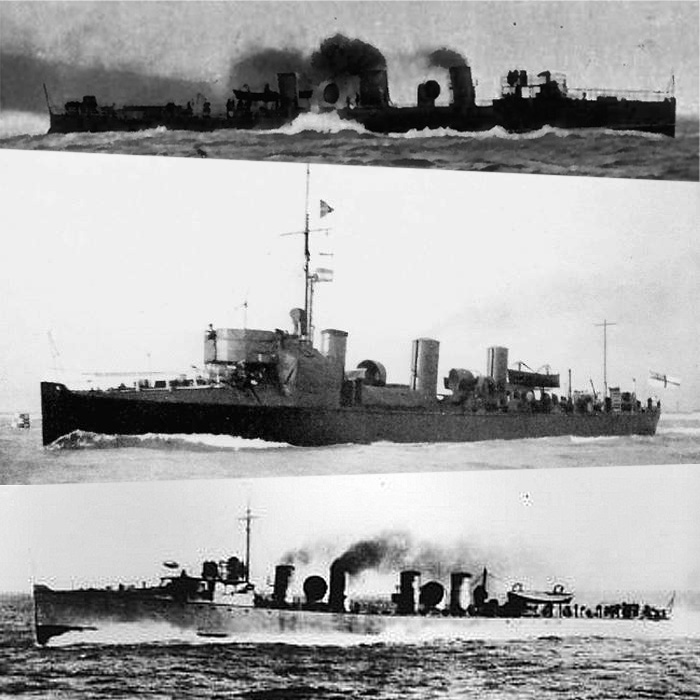
Development
The Royal Navy started to develop “torpedo boat destroyers” in 1892 to counter the new threat of torpedo boats, paradoxically initiated by British manufacturer Whitehead, with France notably in its visor. The basic design was an overgrown torpedo boat loaded with guns and faster than the preys it was supposed to hunt. Development was gradual, with a semi-experimental approach where entire classes (26, 27, then 30 knotters) were declined by as many shipyards as possible to compare the best designs, on a basic identical armament and requirements. However admiralty was found in a predicament as the classic approach of using vertical triple expansion engines with locomotive boilers seemingly approached its limits. For the 1896-97 orders, it was decided to try a 33-knotter class. No ship fitted with triple expansion engines never approached that treshold.
Nevertheless were ordered three more “specials” to selected yards, Thornycroft, Laird and Thomson, motivated notably by the revealation of the French in 1895 testing the new high seas Forban class, allegedly capable of 32-33 knots as published. However none of the three destroyers ordered, completed in 1901-1902 managed more than 30 and 31.5 knots at best on trials. The admiraklty later recoignised this prospect was perhaps too ambitious, but at the same time in 1897 already, Charles A. Parsons with the HM Turbinia, his private yacht demonstrator, proved at Spithead that he was capable to reach 34 knots, so even beyond the ambitious goal fixed by the admiralty with the 33-knotters. The latter then place new orders with Parsons to deliver larger turbines, to be fitted in three new destroyers to test the idea.
Thornycroft’s HMS Albatross, Laird HMS Express and Thomson HMS Arab were larger destroyers, reaching 500 tons fully loaded for the first time, and tyey saw srvoce in WWI reclassed as part of C or D class depending on their funnel numbers. But the admiralty now focused in 1899 in a new class with Parsons turbines on four shafts, two propellers on each, one inboard and one outboard of the shaft A-bracket as Parsons suggested after his tests with the Turbinia.
HMS Viper, thus was the first, ordered to Hawthorn Leslie and Company at Hebburn, River Tyne. The second, “Python”, was built as speculative venture by Hawthorn as well, on a modified design (hence the “viper class” often see in publications also purchased in 1902.
And then was ordered the “Vickers special”, Cobra. But this class, if it proved capable to reach 33 knots and even on trials close to 36 knots (Viper) were lost to accidents, in 1901: HMS Viper foundered on rocks in fog during naval manoeuvres near Alderney on on 3 August and Cobra broke her back in a storm, North Sea, on 18 September 1901. Somewhat disturbed by this bad luck, the admiralty banned snake names for destroyers and “Python” was renamed Velox when completed. The surviving HMS Velox, the only survivors, was not the fastest, but it was trialled hard enough to demonstrated the concept of turbine destroyer, with improvements, was valid. Thus the Royal Navy boldly decided to embark on a new class (collectively called the “rivers”) patrly with turbines and a forecastle for the first time. They are now considered as the second generation of British destroyers.
HMS Velox joined the “C-class” destroyers in 1913, moslty comprising 30-knotters torpedo boat destroyers sporting three funnels, taking part in WWI war patrols against U-Boats.
The ships were considered successes and the River or E class from 1903 did not all had turbines, un fact only three were so fitted. But they proved faster overall due to the forecastle in degraded weather.
Design
Hull and general design
The general design was similar to the 30 and 33-knotters, although with reduced size. The 30 knotters were on average in the 320-380 tonnes range, 215-220 feet long (60+ meters) range, while the 33-knotters reach 500 tonnes fully loaded and were longer. They however all shared the same flush deck with raised stem, turtleback forward of the conning tower protecting the steering wheel, with a platform supporitng the main gun above, wrapped in canvas. The flat deck beyong the bulkwark protecting lighter guns. The two Viper class was back to a reasonable size, HMS Viper being 344 tonnes and Cobra 375 tonnes, Python 400t and 445t fully loaded being the heaviest, for 64-65 meters long (210-215 feet) and from 6 to 6.40 meters or 21 feet in beam.
The armament was kept as the 30 and 33 knotters. The main changes were in the machinery, Viper and Cobra being fitted with the same turbines, the first having two propellers per shaft, and the second three, like HM Turbinia. The third, Python, later renamed Velox (“speed” in latin) was another private venture by Hawthorne Leslie to experiment a mixed powerplant, as it was realized already turbines were not economical at all. So the yard’s chief designer came with the idea of fitting both the same turbines but also classic triple expansion engines. Hence the same hull was lenghtened to house them and the final ship was slightly longer and displaced more, despite having a reduce beam. The TE engines were coupled with the low pressure shafts. The two outer shafts were coupled with the high pressure Turbines. She also had two propellers per shaft, so eight total. She had three funnels, with the larger being truncated from two boilers admiships. She survived trials and saw action in WW1. Velox was 215 feet (65.53 m) long overall for 400 long tons (406 t) normal, 462 long tons (469 t) deep load, a normal stern rudder stern, as well as a retractable rudder fitted forward to help her when running astern.
Powerplant
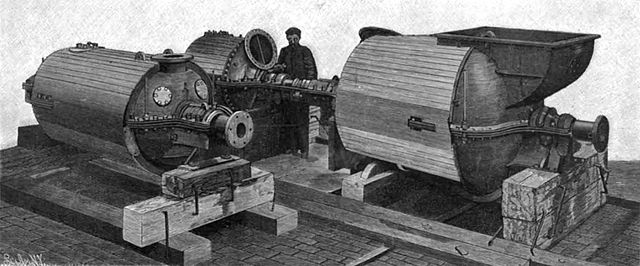
Following the success of the turbine-powered yacht Turbinia, the Admiralty placed an order on 4 March 1898 with Parsons Marine for HMS Viper, subcontracted to Hawthorn Leslie and Comp. Tyneside, aid down later that year with two turbines supplied by Parsons on four shafts, two propellers per shaft. The outer ones had high-pressure turbines the inner ones low-pressure turbines plus separate turbines for running astern. They were all fed by four Yarrow boilers, with uptakes truncated into three funnels. Contract speed was 31 knots (57 km/h; 36 mph), Parsons expressing his confidence in reaching 34 knots (63 km/h; 39 mph).
Launched on 6 September 1899, she made her first trials before commission and after completion, and she comfortably met the contract speed at 31.017 knots (57.443 km/h; 35.694 mph) on 16 August 1900, and 33.57 knots (62.17 km/h; 38.63 mph) on a measured mile on 31 August 1900. She thus took the record as the world’s fastest destroyer. His captain however will later affirm that with favourable conditions he even reached at some point 35.5 knots (65.7 km/h; 40.9 mph)or even 36.858 knots (68.261 km/h; 42.415 mph) in further trials, light (with only a part of the full coal load).
However it was noted she vibrated and her fuel consumption was very high. She was not agile nor efficient at slower speeds and thus could not keep up the distance for Fleet operations. In service she was sent to patrol off Alderney from Portland in a single 24 hours run and back.
Cobra on her side, was a private venture testing a different arrangement, she was launched on 28 June 1899, purchased by the Navy on 8 May 1900 for £70,000. She had four shafts again, and two outer high pressure Parsons turbines, two inner low pressure ones, four boilers, but four funnels. The only major change of the design was the fitting of three propellers per shaft for twelve total, as per Parson’s recommendation. Her contract Speed was 30 knots but like her sister Viper she managed 33 knots over a long enough period with short runs overheating her boilers on lake-like seas, she reached 36.6 knots (67.8 km/h; 42.1 mph). But she was lot (see later) and never really entered service. It was believed her very high consumption would have make her unable to perform fleet duties and she would have only being usable as an “interceptor” for 24 hours runs when noticed, like in the channel.
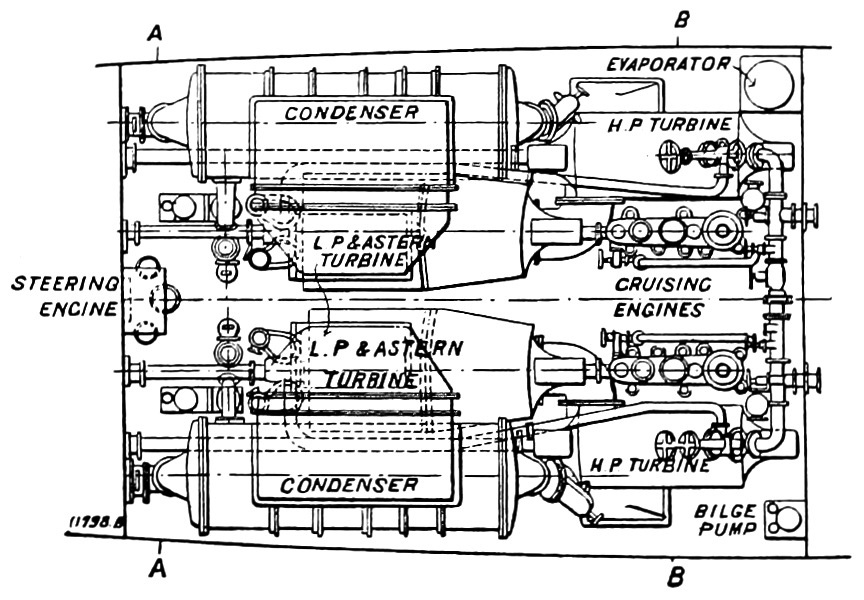
Steam Turbines of HMS Velox
Python was laid down on 10 April 1901 at Hawthorn Leslie as private venture and Co. in Hebburn, Tyneside shipyard, sub-contracted to build the hull and machinery provided by Parsons. She was launched on 11 February 1902. The in house design team instead of using the same high and low pressure turbines proposed by Parsons this time only ordered both high and low pressure models, but also two vertical triple expansion engines to complete the work of the low-pressure steam turbines.
Thus she was powered by two sets of “compound” steam turbines, each with a high-pressure and low-pressure turbines on separate propeller shafts, high-pressure turbines on outer shafts, low-pressure on inner shafts as previous designs, but back to two propellers per shaft and the small triple expansion engines (150 ihp (110 kW) each) being coupled to the inner low-pressure shafts for a more efficient cruising, which was the main critic of the first two vessels. Parsons guaranteed 32 knots (59 km/h; 37 mph) forward, 12 knots (22 km/h; 14 mph) astern in sea trials, and expected 33.7 knots/16 knots respectively on sea trials.
The Admiralty was interested and signe a contract by May 1902, financing the ship, under conditions she was renamed HMS Velox. They also asked not to run her lightly loaded, not representative of service speed, and specified a full load. Parsons thus amended the contract and only promised 27 knots (50 km/h; 31 mph).
Sea trials showed that Velox was still as fast as her sisters at 34.5 knots (63.9 km/h; 39.7 mph) light and 27.249 knots (50.465 km/h; 31.358 mph) fully loaded on a measured mile, 27.142 knots (50.267 km/h; 31.234 mph) on average and with a much higher Fuel consumption as expected, 80% higher than a thirty knotters. She was commissioned in February 1902 but again, there was little hope she could prove useful in service.
Armament
HMS Viper as her sisters Cobra and Python carried the same gun armament as previous 30-33 knotters, a single QF 12 pounder 12 cwt or 3 inches (76 mm) on a platform above the conning tower doubling as bridge plus the usual five 6-pounder (57 mm) guns and two single 18 inch (450 mm) torpedo tubes in the axis amidship and aft. This was standard.
Main: QF 12-pounder 12 cwt naval gun
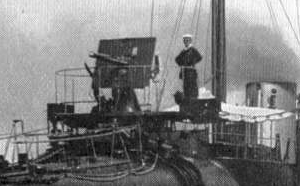 The QF 12-pounder 12 cwt naval gun was brand new when the 26-knotters were in construction, enterering service in 1894. placed on a raised platform overlooking the foredeck, and generally behind a platform protected by canvas. This 0.6 tons (510 kg) ordnance made a superb career going up to 1945, with more than 8,000 delivered. It was also used by Italy and Japan and became the staple of light artillery on most RN ships, especially those of WW1. In the case of these destroyers, the Mark I was shielded and placed on the conning tower platform, high enough to avoid water spray. But in heavy weather, as the ship were ploughing deep due to their turtleback, they were wet anyway.
The QF 12-pounder 12 cwt naval gun was brand new when the 26-knotters were in construction, enterering service in 1894. placed on a raised platform overlooking the foredeck, and generally behind a platform protected by canvas. This 0.6 tons (510 kg) ordnance made a superb career going up to 1945, with more than 8,000 delivered. It was also used by Italy and Japan and became the staple of light artillery on most RN ships, especially those of WW1. In the case of these destroyers, the Mark I was shielded and placed on the conning tower platform, high enough to avoid water spray. But in heavy weather, as the ship were ploughing deep due to their turtleback, they were wet anyway.
Specs:
It used a Separate-loading QF round, caliber 7.62 cm, with a single-motion screw breech.
Rate of fire was 15 rounds per minute, at 2,210 ft/s (670 m/s) for an effective range of 11,750 yd (10,740 m) at 40° for the latter version.
Secondary: 3-5 QF 6-pdr Hotchkiss
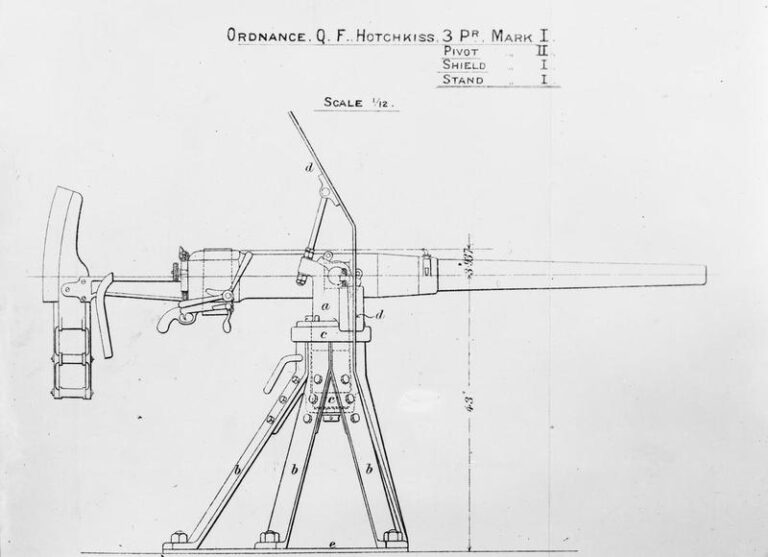
This “classic among classic” was developed in 1883 by Hotchkiss et Cie and a licenced was acquired by Elswick in Britain for mass manufacturing. It became the go-to light QF gun, still very much in favor by the 1890s. Weighting around 821–849 lb (372–385 kg) and shielded, the three guns were located forward for the first pair, abreast the main 12-pdr behind bulwark (but they were wet also) and the third was located on an axial platform aft, close to the stern.
Later in the early 1900s the side TTs were removed and replaced by two more, also shielded, placed on sponsoned platforms for a better arc of fire forward and aft.
Together with the 3-in gun (12 pdr) they could send 140 rounds every minute at the infortunate TB that could cross their path. They generally replaced the dismoured bow tube (not installed on the bulk of the 27 knotters).
Specs:
57x307R 57-millimetre (2.244 in), Vertical sliding-block breech, 4 inch hydro-spring recoil
Rate of fire 25/minute at 1,818 feet per second (554 m/s), range 4,000 yards (3,700 m)
Torpedo Tubes
The Type used was likely the 18-inches Whitehead (45 cm) type, developed in 1888, and introduced as the 26-27 knotters were completed in 1894:
They weighted 845 lbs. (383 kg) for 140 in (3.556 m) in length, with an explosive charge of 118 lbs. (53.5 kg) using wet gun-cotton, single setting, 800 yards (730 m) at 26.5 knots (which was actually slower than the destroyer’s top speed!). It was driven by a three cylinder radial Brotherhood pattern engine, fed by an Air-flask (cold running) of compressed air.
No upgrade as they were ultimately all retired. Outside the bow tube, the two other ones were axial, located aft, often before the aftermost funnel and close to the aft steering post and before the stern gun. Six torpedoes were carried, the three already in the tubes, and three spares.
 HMS Viper (1900)
HMS Viper (1900)

On 3 August 1901, HMS Viper sailed from Portland after her commission, trials and qualifications training. She was to attempt to take part in a search for the annual fleet exercises. She arrived at the Alderney’s Casquet Rocks by mid-afternoon, and started seaching with a visibility degraded by patches of mist, until sighting an “enemy” vessel as part of the exercise. However by the evening, the mist became fog and she went to a crawl at 10 knots.
At 17:23 the spotted sighted the breakers on her starboard bow so she turned to port only to be grounded on more docks. She fought clear only to be grounded again, loosing her propellers, and drifting broadside, tossed onto the rocks so much that by 18:45 her thin hull was shattered, and the engine room was quikly flooded. Heeling over, she was abandoned. Fortunately for the crew, stranded on the rocks, a local pilot’s launch arrived and started to tow the loaded boats ashore. Next day it was discovered she was stranded on Renonquet Rocks and the small team that approach saw her hull had been broken in many places so she was beyond recovery. Her keel was broken, her bow section sheared was bended perpendicular.
There was an enquiry which found guilty the commanding officer Lieutenant William Speke, for not taking the proper precautions while steaming in these conditions, not keeping a record of steering and comparing to the map. Her was dismissed from his post but merely reprimanded. Navigating officer Sub-Lieutenant Kenneth Mackenzie Grieve was also reprimanded to have fail to enter the tseeting data, only making so into the log following the wreck. By December 1901 the wreck was sold to Messrs. Agnes and Co., of Southampton to be BU for £100.
⚙ specifications (Albatross) |
|
| Displacement | 344t normal, 393 t deep load |
| Dimensions | 210 ft 3+1⁄2 in 21 ft x 9 ft 9 in (64.1 x 6.4 x 2.97 m) |
| Propulsion | 4 Parsons turbines, 10,600 ihp (7,904 kW), 4 boilers |
| Speed | 33.8 knots and more on trials |
| Range | coal 105 tons, 3000 nm at 10 kts |
| Armament | 1x 12pdr or 3-in (76mm/40) or 12cwt QF Mk I, 5x 6 pdr (57mm/40) Hotchkiss Mk I, 2x 450mm TT (4) |
| Crew | 68 |
 HMS Velox (1903)
HMS Velox (1903)
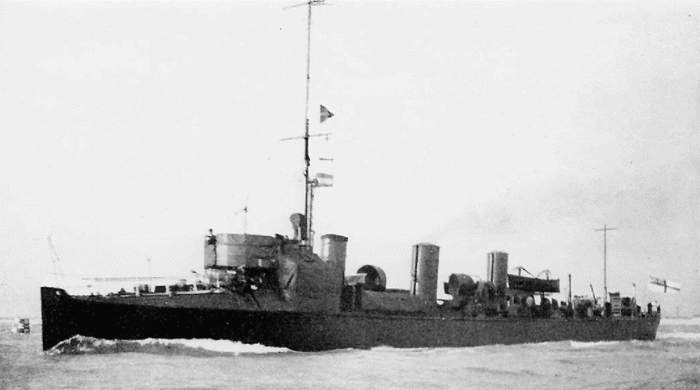
HMS Velox on trials showed the highest fuel consumption of all three Hatwthorn sisters. Her alternative cruising engines powered her only to 10.35 knots (19.17 km/h, 11.91 mph) and she was afflicted by a poor astern speed of 5 knots and in any way had troubles to run astern whereas her condensers were badly placed. She obtained new cruising turbines in 1907.
By May 1909, she was passing Lands End when loosing her port engines, and heavy rolling saw feedwater not entering her condensers, leading to full power close to the shore. She was however recovered and towed back to port but after this, transferred from HMS Vernon (torpedo establishment) for training and by 30 August 1912 she entered the C Class (3 funnels).
In August 1914 until January 1915, she kept her training role, but was passed onto the Portsmouth flotilla.
By 25 October 1915, she patrolled with HMS Conflict when her condenser again ingested seawater and she was forced to back down to calmer waters close to the Isle of Wight, when hitting a mine previously laid by UC-5 off the Nab Lightship. The explosion killed four crewmen and nearly severed her stern. Another destroyer tried to tow her to safety but failed and she flooded until foundering. The site today is circa 1.5 miles east of Bembridge, Solent and most of her wreckage was recovered, but divers continue to discover artifacts while a new survey was condicted by the Maritime Archaeology Trust in 2010.
⚙ specifications (Python/Velox) |
|
| Displacement | 400t normal, 462t deep load |
| Dimensions | 215 x 21 x 5 ft 11 in (65.53 x 6.41 x 1.80 m) |
| Propulsion | 4 shafts Parsons turbines, 4 boilers |
| Speed | 27 knots (50 km/h; 31 mph) full load |
| Range | coal 109 tons, 3000 nm at 10 kts |
| Armament | 1x 12pdr or 3-in (76mm/40) or 12cwt QF Mk I, 5x 6 pdr (57mm/40) Hotchkiss Mk I, 2x 450mm TT (4) |
| Crew | 63 |
 HMS Cobra (1902)
HMS Cobra (1902)
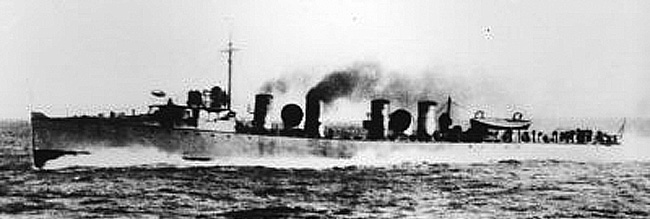
HMS Cobra was partly design based on the HMS Swordfish and Spitfire at the same yard under Director of Naval Construction, Sir William Henry White. He however considered not strong enough compared to navy requirement but did not object to her hull design and it was intended that the Admiralty would purchase her, notably to prevent her sale to a foreign navy.
She had the shortest carrier of all three sisters, making her first steam trials in June 1900, after being completed with Admiralty alterations, completing all official trials by September 1901. Her first captain was Lieutenant Bosworth Smith completed by two officers and 48 men and she was schedule to depart Newcastle to Portsmouth and there receiving her guns and ammunition.
She left Elswick at 11:00 on 17 September, went along the Tyne, up to its mouth at 19:00 and then proceeding off shore at 17 kn (20 mph; 31 km/h) under a strong NNW wind and rough sea. She started to roll so much her stokers failed to feed coal to the boilers, her speed falling to 5 knots at 22:00. By the next early morning conditions were still hard, the stokers could hardly stand in the stokehold but conditions subsided enough by dawn to regain 8 kn (9.2 mph; 15 km/h) and at 07:00 she spotted the lightvessel 3 mi (4.8 km) away. She altered course towards her to be recoignised, while the lightvessel’s crew recorded she was “plunging heavily” until in a cloud of steam, she sudenly broke in two. The stern sank quickly with trapped crewmen aboard, but the bow continued to drift.
As reported by Chief Engineer Percey the break seemingly occured at 07:15 and it seemed she had had hit something. There was an attempt to launch her whaler, but it capsized from overcrowding. The three collapsible boats could not be assembled in time befote she sank but still many found refuge on the 14 ft (4.3 m) dinghy under orders by Petty Officer Francis Barns. When the weather calmed down enough, thee more hanging in the water aroundcould climb aboard as well. 12 survivors were picked up by the steamer Harlington, landed at Middlesbrough. This still in the water had lifebelts but still drowned of exhaustion and cold in the heavy seas. Lt. Smith was missing, likely clinging to the wheel on the front part before it sank.
The fishing lighter ’15’ later departed Great Yarmouth harbour to the South Dowsing light and picked up two dead men and reached the wreck of Cobra, seeing 15 ft of the forward portion was still sticking out of the water. She later found Cobra’s whaler floating upside down and picked up more bodies. On 20 September there was an attempt to tow the wreck but failed while a Swedish diver, Mr. Frank Carlson inspected the wreck.
Due to the loss of the ship and most of the crew, there was a court-martial and committee of enquiry The “Cobra Inquiry”) lead by Rear-Admiral Pelham Aldrich on 10 October 1901. Mr. Philip Watts was also called to testify as naval architect, future DNC for the Admiralty. It was established Cobra was longer and weaker than Swordfish but with a 17% stronger keel and deeper draught. Parson’s engine proved 28 long tons (28.4 t) heavier than designed and she was overall 20 long tons over specs, at 450 long tons. The diver found and indentation in keel plate and Watts estimated she should have struck the mast of a wrecked ship, which was never found. In the end the court estimated she broke up due to structural weaknesses and criticised White for greenlighting the purchase.
By November 1901 under Vice-Admiral Rawson a more general inspection was started on other destroyers to jauge of their potential weaknesses, notably by testing HMS Wolf, only supported by cradles hanging into the air. The results confirmed calculations of strenght, and confirmed by sea trials. In the end it was concluded that Cobra was weaker than most. Results were classified for 50 years. Today it is estimated she struck timber floating in the water denting the keel plate, and the further back at a weaker point in the bottom plating, holing it, the waved compounding the effect, according to the two shocks reported by some survivors. The partial floosing of the boiler room was also finally responsible for the whole hull to break.
⚙ specifications Cobra |
|
| Displacement | 400 long tons (410 t) |
| Dimensions | 223 ft (68 m) |
| Propulsion | 4× shafts Parsons turbines, 4x Yarrow boilers 11,500 shp (8,600 kW) |
| Speed | 36.6 knots (67.8 km/h; 42.1 mph) |
| Range | coal 130 tons, 3000 nm at 10 kts |
| Armament | 1x 12pdr or 3-in (76mm/40) or 12cwt QF Mk I, 5x 6 pdr (57mm/40) Hotchkiss Mk I, 2x 450mm TT (4) |
| Crew | 69 |
Read More/Src
Books
K. C. Barnaby (1968). Some Ship Disasters and their Causes. London: Hutchinson and Company.
Chesneau, Roger & Kolesnik, Eugene M., eds. (1979). Conway’s All The World’s Fighting Ships 1860–1905. Conways
Colledge, J. J.; Warlow, Ben (2006). Ships of the Royal Navy. Chatham Publishing.
Dittmar, F.J.; Colledge, J.J. (1972). British Warships 1914–1919. Shepperton, UK: Ian Allan.
Friedman, Norman (2009). British Destroyers: From Earliest Days to the Second World War. Barnsley.
Gardiner, Robert & Gray, Randal, eds. (1985). Conway’s All The World’s Fighting Ships 1906–1921. Conway Maritime Press.
Lyon, David (2001) [1996]. The First Destroyers. London: Caxton Editions.
Manning, T. D. (1961). The British Destroyer. London: Putnam & Co.
March, Edgar J. (1966). British Destroyers: A History of Development, 1892–1953. London: Seeley Service.
“The Loss Of The Cobra”. The Times. No. 36566. London. 21 September 1901. p. 11. Retrieved 12 December 2023
“The Loss Of The Cobra: Verdict Of The Court-Martial”. The Times. No. 36588. London. 17 October 1901
Links
digital.nls.uk british-military-lists
http://www.rmg.co.uk Warship Histories Vessels
naval-history.net/ BritishShips-Locations
digital.nls.uk/ british-military-lists/
naval-history.net/ BritishShips-Locations
naval-history.net/ BritishShips-Locations
naval-history.net BritishShips-Locations
navypedia.org uk_torpedoships.htm
wiki/HMS_Express
wiki/HMS_Arab

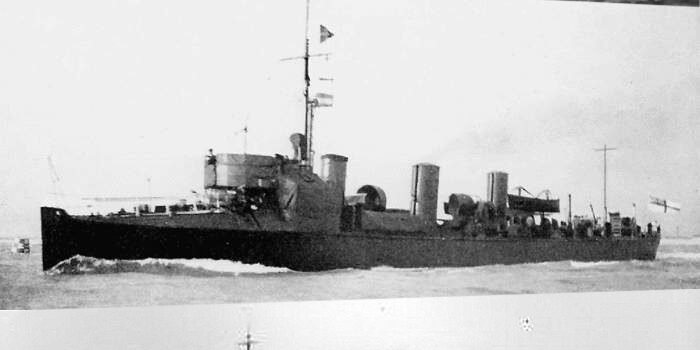

 Latest Facebook Entry -
Latest Facebook Entry -  X(Tweeter) Naval Encyclopedia's deck archive
X(Tweeter) Naval Encyclopedia's deck archive Instagram (@navalencyc)
Instagram (@navalencyc)





 Austrian Navy
Austrian Navy French Navy
French Navy Royal Navy
Royal Navy Armada Espanola
Armada Espanola K.u.K. Kriegsmarine
K.u.K. Kriegsmarine Dansk Marine
Dansk Marine Nautiko Hellenon
Nautiko Hellenon Koninklije Marine 1870
Koninklije Marine 1870 Marinha do Brasil
Marinha do Brasil Osmanlı Donanması
Osmanlı Donanması Marina Do Peru
Marina Do Peru Marinha do Portugal
Marinha do Portugal Regia Marina 1870
Regia Marina 1870 Nihhon Kaigun 1870
Nihhon Kaigun 1870 Preußische Marine 1870
Preußische Marine 1870 Russkiy Flot 1870
Russkiy Flot 1870 Svenska marinen
Svenska marinen Søværnet
Søværnet Union Navy
Union Navy Confederate Navy
Confederate Navy Armada de Argentina
Armada de Argentina Imperial Chinese Navy
Imperial Chinese Navy Marinha do Portugal
Marinha do Portugal Mexico
Mexico Kaiserliche Marine
Kaiserliche Marine 1898 US Navy
1898 US Navy Russkiy Flot
Russkiy Flot French Naval Aviation
French Naval Aviation Russian Naval Aviation
Russian Naval Aviation Sovietskiy Flot
Sovietskiy Flot Royal Canadian Navy
Royal Canadian Navy Royal Australian Navy
Royal Australian Navy RNZN Fleet
RNZN Fleet Chinese Navy 1937
Chinese Navy 1937 Kriegsmarine
Kriegsmarine Chilean Navy
Chilean Navy Danish Navy
Danish Navy Finnish Navy
Finnish Navy Hellenic Navy
Hellenic Navy Polish Navy
Polish Navy Romanian Navy
Romanian Navy Turkish Navy
Turkish Navy Royal Yugoslav Navy
Royal Yugoslav Navy Royal Thai Navy
Royal Thai Navy Minor Navies
Minor Navies Albania
Albania Austria
Austria Belgium
Belgium Columbia
Columbia Costa Rica
Costa Rica Cuba
Cuba Czechoslovakia
Czechoslovakia Dominican Republic
Dominican Republic Haiti
Haiti Hungary
Hungary Honduras
Honduras Estonia
Estonia Iceland
Iceland Eire
Eire Equador
Equador Iran
Iran Iraq
Iraq Latvia
Latvia Liberia
Liberia Lithuania
Lithuania Mandchukuo
Mandchukuo Morocco
Morocco Nicaragua
Nicaragua Persia
Persia San Salvador
San Salvador Sarawak
Sarawak Uruguay
Uruguay Venezuela
Venezuela Zanzibar
Zanzibar Warsaw Pact Navies
Warsaw Pact Navies Bulgaria
Bulgaria Hungary
Hungary

 Bundesmarine
Bundesmarine Dutch Navy
Dutch Navy Hellenic Navy
Hellenic Navy Marina Militare
Marina Militare Taiwanese Navy
Taiwanese Navy Chinese Navy
Chinese Navy Indian Navy
Indian Navy Indonesian Navy
Indonesian Navy JMSDF
JMSDF North Korean Navy
North Korean Navy Philippines Navy
Philippines Navy ROKN
ROKN IDF Navy
IDF Navy Royal New Zealand Navy
Royal New Zealand Navy Egyptian Navy
Egyptian Navy South African Navy
South African Navy

































 RN
RN
 Marine Nationale
Marine Nationale
 Soviet Navy
Soviet Navy
 dbodesign
dbodesign